Looking to start your artistic journey with graphite drawing? This comprehensive guide breaks down the best brands and products for beginners, helping you build a quality collection of drawing materials without wasting money on subpar supplies.
Introduction: Finding Quality in a Sea of Options
The art supply market is flooded with options ranging from professional-grade to budget alternatives, making it overwhelming for beginners to know where to invest their money. While talent ultimately transcends tools, working with quality materials can significantly enhance your learning experience and results.
In this definitive guide, we’ll explore the best brands and specific products for graphite drawing, comparing options across price points to help you make informed decisions. Whether you’re a complete beginner or looking to upgrade your existing supplies, this curated selection represents the best in graphite drawing materials based on artist feedback, durability, performance, and value.
Premium Graphite Pencils: The Best Brands Worth Your Investment
Top-Tier Graphite Pencil Brands
The foundation of any graphite drawing practice lies in quality pencils. These top brands consistently deliver exceptional performance:
1. Faber-Castell 9000 Series ($15-25 for set of 12)
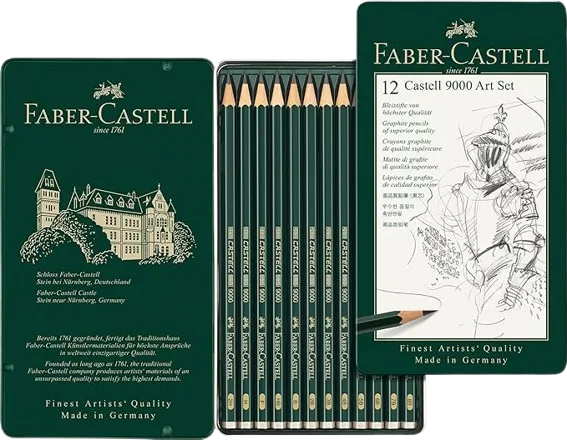
- Pros: Consistent hardness across grades, break-resistant lead due to special bonding process, smooth laydown
- Cons: Slightly higher price point
- Best for: Artists seeking professional quality with excellent consistency
- Standout Product: Faber-Castell 9000 Graphite Pencil Art Set (includes 8B-2H)
2. Staedtler Mars Lumograph ($12-20 for set of 12)
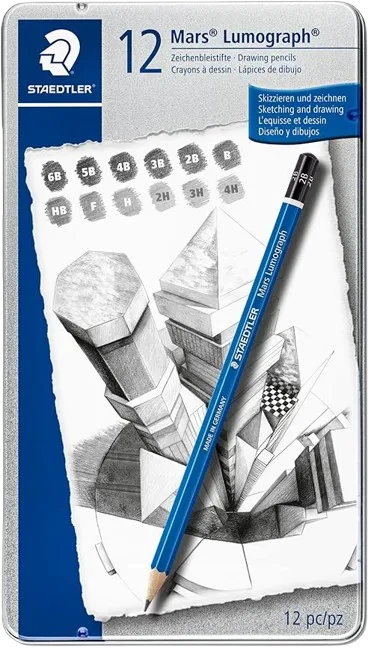
- Pros: Excellent lead strength, minimal crumbling, precise line control
- Cons: Slightly harder than comparable grades from other brands
- Best for: Technical drawing and detailed work
- Standout Product: Staedtler Mars Lumograph Premium Quality Art Pencil Set
3. Mitsubishi Hi-Uni ($25-35 for set of 12)

- Pros: Buttery-smooth application, richest blacks in soft grades, consistent performance
- Cons: Limited availability, higher price point
- Best for: Professional artists and serious hobbyists
- Standout Product: Mitsubishi Hi-Uni 22 Degree Hardness Scale Set
4. Caran d’Ache Grafwood ($25-40 for set of 12)
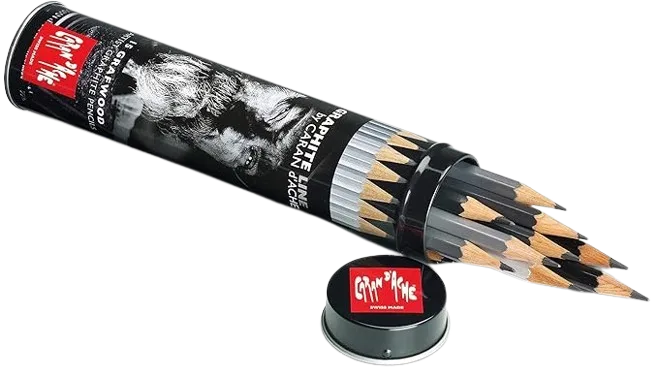
- Pros: Swiss-made luxury pencils, water-resistant graphite, extraordinary smoothness, vibrant dark tones
- Cons: Premium price point, limited availability in some regions
- Best for: Professional artists, fine art applications, and those seeking the ultimate drawing experience
- Standout Product: Caran d’Ache Grafwood Graphite Pencil Set
Best Value Graphite Pencil Sets
For beginners balancing quality with budget considerations:
1. Derwent Graphic ($10-18 for set of 12)
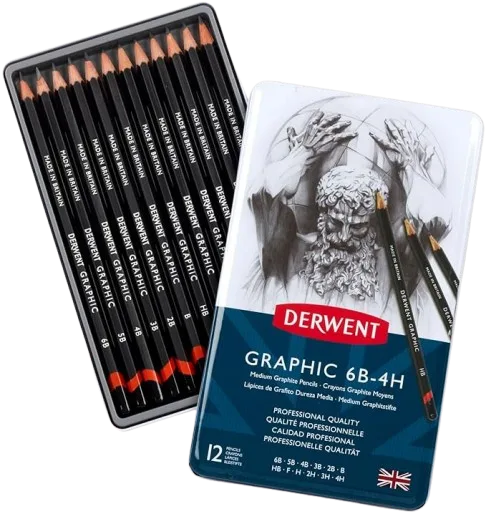
- Pros: Good quality-to-price ratio, wide grade availability, reliable performance
- Cons: Not as smooth as premium options
- Best for: Students and beginners
- Standout Product: Derwent Graphic Medium Pencil Set
2. Prismacolor Graphite Drawing Set ($10-15 for 7-piece set)
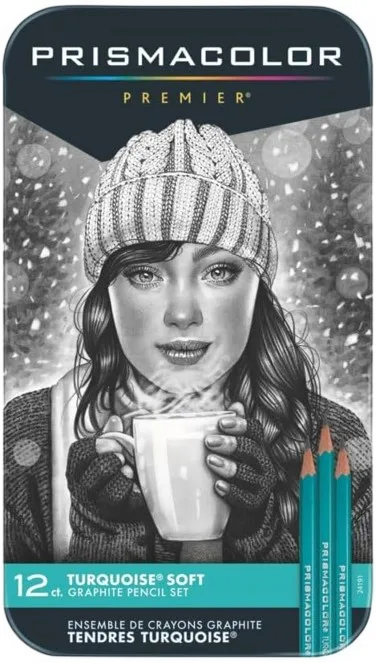
- Pros: Rich blacks in softer grades, consistent cores, accessible price
- Cons: Limited grade options in sets
- Best for: Beginners focusing on sketching and shading
- Standout Product: Prismacolor Premier Graphite Drawing Pencils with Eraser & Sharpener Set
3. General’s Kimberly ($8-12 for set of 12)

- Pros: American-made, excellent value, good dark tones
- Cons: Not as refined as premium brands
- Best for: Students and casual artists
- Standout Product: General’s Kimberly Graphite Pencil Kit
Premium Drawing Papers: Surfaces That Elevate Your Work
Best Drawing Paper Brands for Graphite
The paper you choose dramatically impacts your drawing experience and results:
1. Strathmore 400 Series Drawing Paper ($12-18 for 24-sheet pad)

- Pros: Professional quality, acid-free, excellent tooth for graphite
- Cons: May be too textured for extremely detailed work
- Best for: General drawing and finished pieces
- Standout Product: Strathmore 400 Series Drawing Pad, Medium Surface, 80 lb, 9″x12″
2. Fabriano Accademia ($15-20 for 30-sheet pad)

- Pros: Acid-free, chlorine-free paper with excellent tooth, performs well with both wet and dry media
- Cons: More expensive than student-grade options
- Best for: Versatile drawing applications and mixed media exploration
- Standout Product: Fabriano Accademia Drawing Pad, 120 gsm, 9″x12″
3. Fabriano Artistico ($20-30 for 15-sheet pad)

- Pros: Museum-quality, 100% cotton, archival, wonderful texture
- Cons: Premium price point
- Best for: Finished artwork and professional pieces
- Standout Product: Fabriano Artistico Traditional White Watercolor Paper, Hot Press (smooth for detailed graphite work)
4. Arches Hot Press Watercolor Paper ($25-35 for 10-sheet pad)
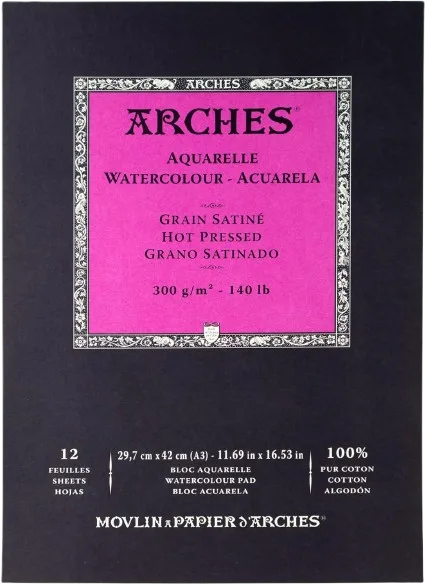
- Pros: Professional-grade 100% cotton, excellent for detailed graphite work
- Cons: Expensive, thicker than typical drawing paper
- Best for: Archival, gallery-quality finished pieces
- Standout Product: Arches Hot Press Watercolor Block, 140 lb
Best Sketchbooks for Graphite Drawing
For practice, studies, and portable drawing:
1. Moleskine Art Collection Sketchbook ($15-25)
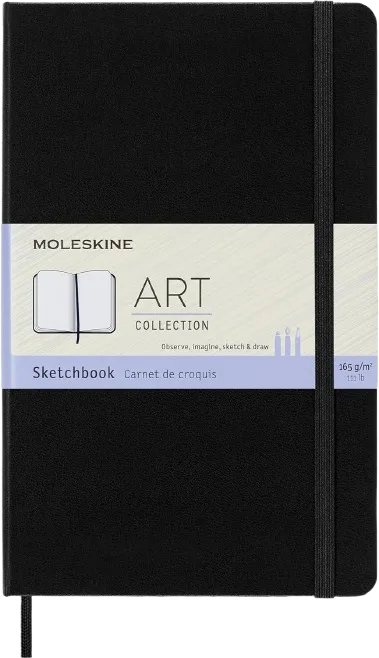
- Pros: Portable, lies flat, good paper quality, elegant presentation
- Cons: Limited paper weight compared to dedicated drawing pads
- Best for: Daily sketching and practice
- Standout Product: Moleskine Art Collection Sketchbook, Large, Black
2. Strathmore 400 Series Sketchbook ($10-15)

- Pros: Excellent paper quality, spiral-bound for flat working surface
- Cons: Bulkier than some portable options
- Best for: Serious sketching and preliminary work
- Standout Product: Strathmore 400 Series Sketch Pad, 11″x14″, Wire Bound
3. Leuchtturm1917 Sketchbook ($18-25)
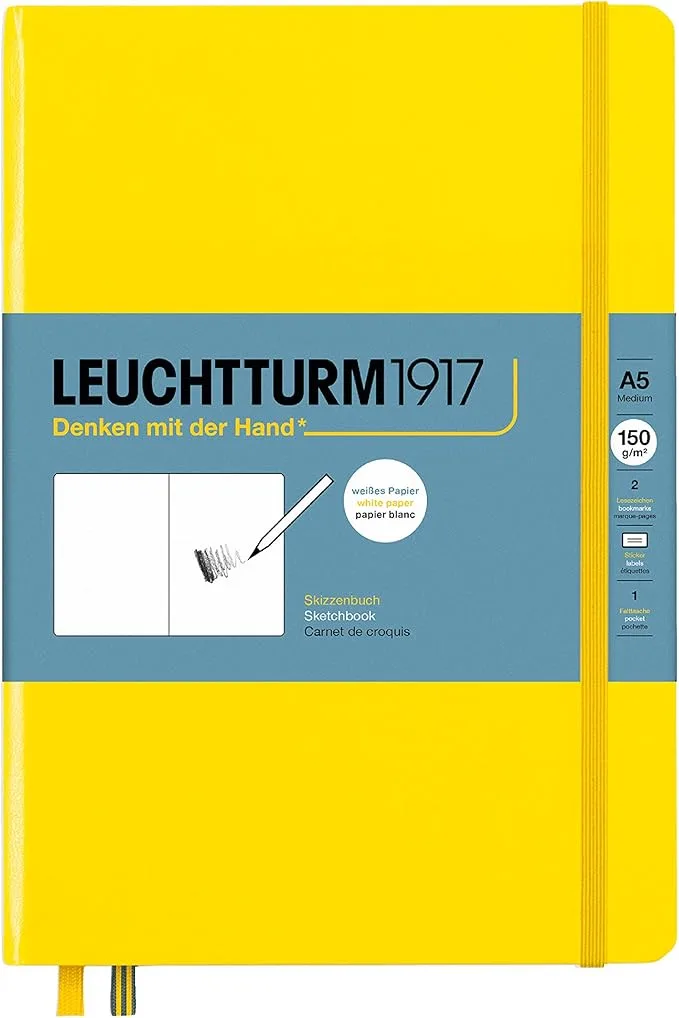
- Pros: High-quality paper, numbered pages, elegant binding
- Cons: Higher price point, limited availability
- Best for: Archiving sketches in a journal format
- Standout Product: Leuchtturm1917 Medium A5 Sketchbook, Hardcover
Superior Erasers: Precision Tools for Correction and Highlights
Best Erasers for Graphite Work
Quality erasers are essential for both corrections and creative techniques:
1. Tombow Mono Zero Precision Eraser ($5-7)
- Pros: Ultra-precise 2mm tip, retractable, perfect for detailed work
- Cons: Needs refills, small erasing area
- Best for: Highlights and fine detail work
- Standout Product: Tombow Mono Zero Eraser, Round Tip
2. Staedtler Mars Plastic Eraser ($1-3)
- Pros: Clean erasing with minimal residue, durable, excellent value
- Cons: Not as specialized as other options
- Best for: General erasing and clean-up
- Standout Product: Staedtler Mars Plastic Eraser, White
3. Faber-Castell PITT Graphite Matte Eraser Pencil ($2-4)
- Pros: Precise application, convenient pencil form
- Cons: Needs sharpening, smaller erasing surface
- Best for: Controlled erasing in specific areas
- Standout Product: Faber-Castell PITT Graphite Matte Eraser Pencil
4. Prismacolor Kneaded Rubber Eraser ($1-3)
- Pros: Moldable for precision, doesn’t leave residue, lifts rather than rubs
- Cons: Needs cleaning and occasional replacement as it gets dirty
- Best for: Lightening areas, creating highlights, gentle erasing
- Standout Product: Prismacolor Premier Kneaded Rubber Eraser
Premium Blending and Shading Tools
Best Blending Tools for Smooth Results
These tools help achieve professional-looking transitions and textures:
1. Prismacolor Blending Stumps ($3-6 for set of 6)
- Pros: Various sizes, tightly rolled for precision, excellent blending capability
- Cons: Need cleaning or replacement when heavily used
- Best for: Controlled blending in specific areas
- Standout Product: Prismacolor Premier Blending Stumps and Tortillons
2. Pro Art Blending Tortillons ($3-5 for pack of 12)
- Pros: Economical, disposable, good variety of sizes
- Cons: Less durable than stumps
- Best for: Fine blending work and beginners
- Standout Product: Pro Art 6-Inch Tortillon Blending Stumps
3. Cretacolor Artists’ Chamois ($5-8)
- Pros: Real leather, excellent for large area blending, long-lasting
- Cons: Requires cleaning, higher initial investment
- Best for: Smooth, even tones over larger areas
- Standout Product: Cretacolor Artist’s Chamois, Natural
Essential Accessories: Completing Your Toolkit
Best Pencil Sharpeners for Graphite Artists
The right sharpener preserves your pencils and creates the perfect point:
1. Staedtler Metal Double-Hole Sharpener ($4-6)
- Pros: Durable metal construction, two hole sizes, excellent point
- Cons: No shaving reservoir
- Best for: Precision sharpening
- Standout Product: Staedtler Metal Double-Hole Sharpener
2. Kum Long Point Pencil Sharpener ($6-8)
- Pros: Two-stage sharpening process for the perfect long point
- Cons: Slightly more complex to use
- Best for: Artists who require precise, long points
- Standout Product: Kum Masterpiece Pencil Sharpener
3. Alvin Brass Bullet Sharpener ($4-6)
- Pros: Compact, durable brass construction, portable
- Cons: No reservoir for shavings
- Best for: Traveling artists, field sketching
- Standout Product: Alvin Brass Bullet Pencil Sharpener
Best Fixatives for Preserving Your Work
Protect finished drawings from smudging with these quality fixatives:
1. Krylon Workable Fixatif ($6-10)
- Pros: Allows additional work after application, archival quality
- Cons: Strong odor, requires ventilation
- Best for: Work in progress
- Standout Product: Krylon K01306 Workable Fixatif Spray
2. Winsor & Newton Artists’ Fixative ($10-15)
- Pros: Professional quality, minimal color shifting, good protection
- Cons: Higher price point
- Best for: Finished artworks
- Standout Product: Winsor & Newton Artists’ Fixative
3. SpectraFix Natural Fixative ($15-20)
- Pros: Non-toxic, casein-based, low odor
- Cons: Less holding power than synthetic options
- Best for: Artists sensitive to chemicals, studio use near other people
- Standout Product: SpectraFix SFX-31023 Pastel Fixative
Building Your Kit: Budget Levels and Recommendations
Starter Kit: Quality on a Budget ($30-50)
Even with limited funds, you can assemble excellent materials:
- Pencils: Derwent Graphic Drawing Pencils (6-pencil set: HB, 2B, 4B, 6B, 2H, 4H) – $8
- Paper: Canson XL Series Drawing Pad – $8
- Erasers: Staedtler Mars Plastic and Prismacolor Kneaded – $4
- Sharpener: Staedtler Metal Double-Hole Sharpener – $5
- Blending: Pro Art Tortillons (pack of 6) – $3
- Optional: Strathmore 300 Series Sketchbook – $7
Intermediate Kit: Serious Beginner Investment ($75-100)
For those ready to commit to regular practice:
- Pencils: Staedtler Mars Lumograph (12-pencil set) – $18
- Paper: Strathmore 400 Series Drawing Pad and 400 Series Sketchbook – $25
- Erasers: Tombow Mono Zero, Staedtler Mars Plastic, and Prismacolor Kneaded – $10
- Sharpener: Kum Long Point Sharpener – $7
- Blending: Prismacolor Blending Stumps and Cretacolor Chamois – $10
- Protection: Krylon Workable Fixatif – $8
Professional Kit: No Compromises ($150-200)
For the serious artist seeking the best tools:
- Pencils: Mitsubishi Hi-Uni or Faber-Castell 9000 (full range set) – $35
- Paper: Combination of Strathmore 500 Series and Fabriano Artistico – $45
- Sketchbook: Moleskine Art Collection and Strathmore 400 Toned – $40
- Erasers: Complete set (Tombow Mono Zero, Faber-Castell Pencil Eraser, Staedtler Mars Plastic, Prismacolor Kneaded) – $15
- Sharpeners: Kum Long Point and Alvin Brass Bullet – $12
- Blending: Full range of stumps, tortillons, and chamois – $15
- Protection: Winsor & Newton Artists’ Fixative – $12
Comparative Analysis: When to Splurge vs. Save
Worth the Splurge
These items justify spending more:
- Pencils: The core of your practice; higher-grade pencils offer better consistency, smoother application, and richer blacks
- Paper for finished work: Archival paper ensures your best pieces last for generations
- Precision erasers: Tools like the Tombow Mono Zero transform erasing from correction to creative technique
Where to Save
These items offer diminishing returns at higher price points:
- Practice paper: Use more affordable options for studies and practices
- Basic erasers: Even budget kneaded erasers perform well
- Blending tools: Mid-range options typically perform nearly as well as premium versions
Expert Reviews: Artists’ Favorite Combinations
We asked professional graphite artists about their preferred materials combinations:
Sarah Chen, Portrait Artist: “I rely on Mitsubishi Hi-Uni pencils (4H, 2H, HB, 2B, 4B, 6B) on Strathmore 500 Series Bristol with a smooth finish. For precision work, nothing beats the Tombow Mono Zero eraser, and I use Prismacolor blending stumps for soft transitions in skin tones.”
Michael Torres, Architectural Illustrator: “Staedtler Mars Lumograph pencils on Arches Hot Press watercolor paper give me the control I need for detailed architectural renderings. The Kum Long Point sharpener creates the perfect tip for fine linework.”
Eliza Montgomery, Nature Sketcher: “For field sketching, I never leave without my Faber-Castell 9000 pencils (HB, 2B, 4B, 6B), a Moleskine Art sketchbook, and an Alvin Brass Bullet sharpener. This combination withstands outdoor conditions while delivering quality results.”
Where to Purchase: Finding the Best Deals
Best Retailers for Quality and Selection
- Blick Art Materials (dickblick.com): Comprehensive selection, frequent sales, bulk discounts
- Jerry’s Artarama (jerrysartarama.com): Competitive pricing, excellent variety, regular promotions
- Amazon: Convenience and often the best prices on specific items
- Jackson’s Art Supplies (jacksonsart.com): Excellent international brands, quality focus
Specialty Retailers Worth Exploring
- CW Pencil Enterprise (cwpencils.com): Pencil specialists with rare and international brands
- Jetpens.com: Excellent for Japanese brands like Tombow and Mitsubishi
- New York Central Art Supply (centralartsupply.com): Outstanding paper selection
Techniques and Tips from the Masters
Getting the Most from Your Materials
- Pencil rotation: Develop the habit of slowly rotating your pencil while drawing to maintain a consistent edge and even wear
- Paper positioning: Place a clean sheet under your drawing hand to prevent oils and smudges
- Test and swatch: Create a reference card showing how each pencil grade performs on your preferred papers
- Preservation techniques: Store graphite drawings between acid-free tissue paper or in portfolio sleeves
Conclusion: Investing in Your Artistic Journey
Quality materials won’t make you a great artist overnight, but they remove unnecessary barriers from your creative process. By investing strategically in the brands and products recommended in this guide, you’ll build a toolkit that supports your growth rather than limiting it.
Remember that personal preference plays a significant role in art supplies—what works perfectly for one artist may feel uncomfortable to another. Start with these curated recommendations, then adjust based on your experience and developing style.
The most important investment remains your practice time. Even modest materials in dedicated hands will produce more impressive results than premium supplies used occasionally. Pair quality tools with consistent practice, and watch your graphite skills flourish.
Ready to build your ideal graphite drawing kit? Share your favorite brand combinations in the comments below, or tag us in photos of your setup using #GraphiteMaster.



0 Comments